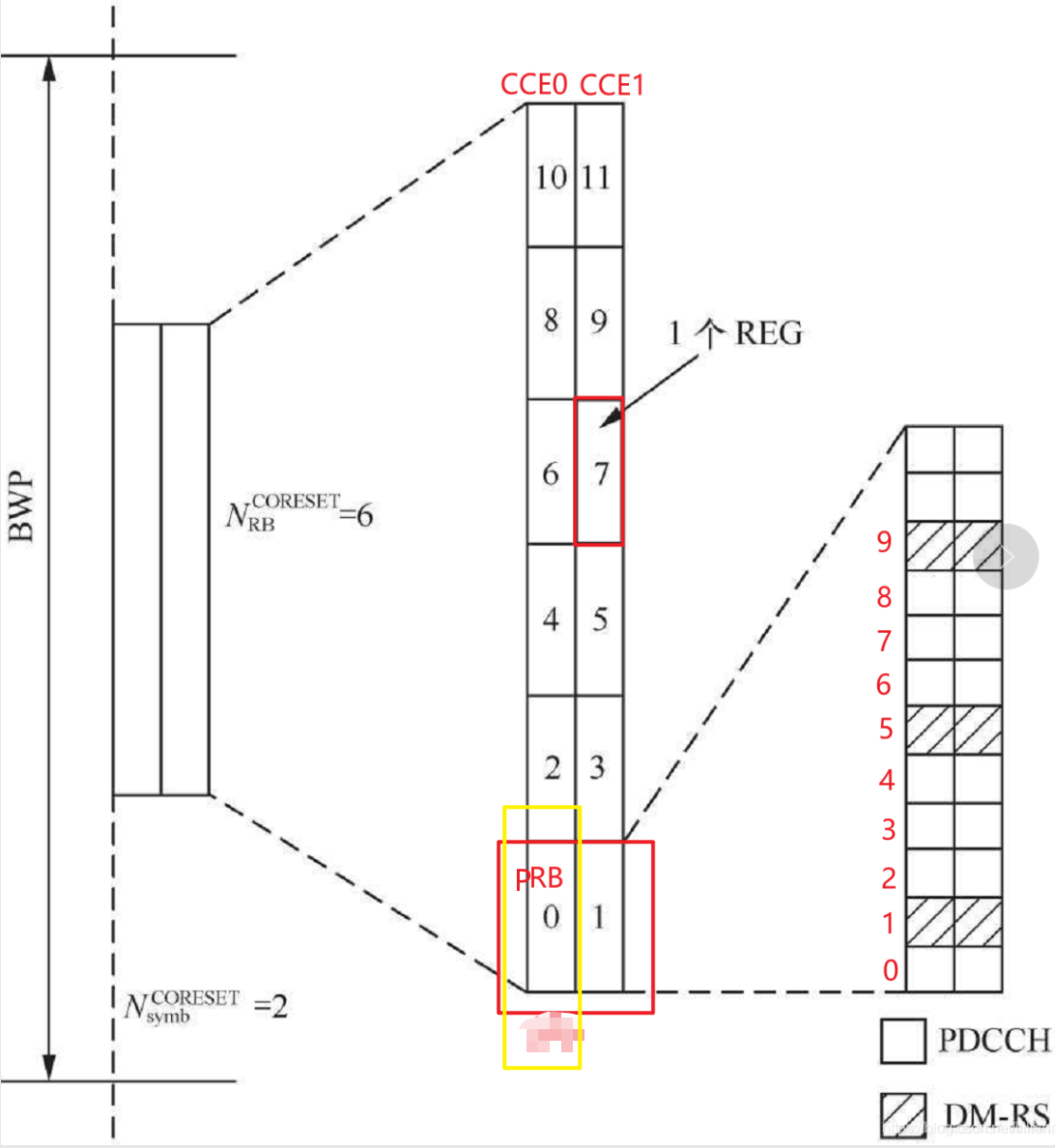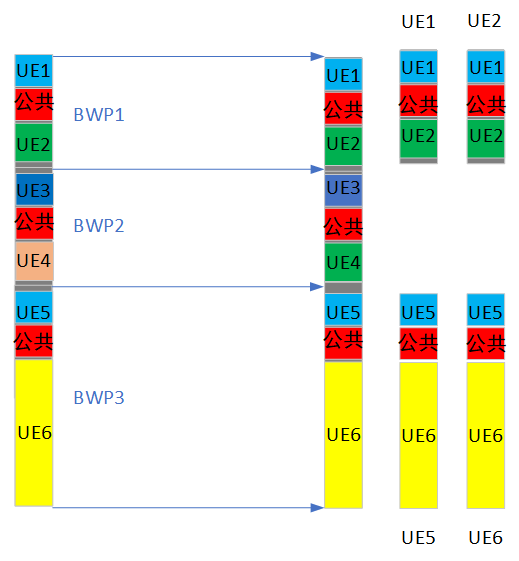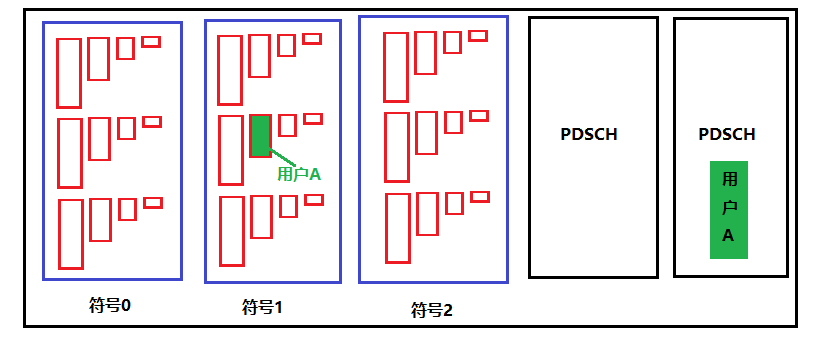作者主页(文火冰糖的硅基工坊):文火冰糖(王文兵)的博客_文火冰糖的硅基工坊_CSDN博客
本文网址:FAPI专题-8:5G FAPI接口 – 中文规范-4- P7消息格式
目录
3.4 P7接口的Slot Messages(时隙调度消息)
3.4.2.1 PDCCH PDU (对下行控制信道的调度)
3.4.2.5 Tx Precoding and Beamforming PDU
3.4.6 UCI.indication(上行调度请求指示)
3.4.6.3 PUCCH PDU Format 2/3/4
3.4.6.4 SR, HARQ and CSI Part 1/ 2 PDUs
目录
3.4 P7接口的Slot Messages(时隙调度消息)
3.4.2.1 PDCCH PDU (对下行控制信道的调度)
3.4.2.5 Tx Precoding and Beamforming PDU
3.4.6 UCI.indication(上行调度请求指示)
3.4.6.3 PUCCH PDU Format 2/3/4
3.4.6.4 SR, HARQ and CSI Part 1/ 2 PDUs
第1章 概述
第2章 主要的流程
第3章 主要的消息格式
3.1 General Message Format (通用消息格式)
3.2 Message Types (消息类型)
3.3 P5接口的Configuration Messages(管理配置消息)
3.4 P7接口的Slot Messages(时隙调度消息)
该组Slot消息被用于L2软件控制每个Slot数据的发送和接收。
正是通过这组消息,L2和L1之间才实现了有节奏的发送和接收数据 。
3.4.1 Slot.indication
当MAC层调度器和PHY在同一个硬件单元中时,使用该消息在MAC层和PHY层之间进行时隙对齐。也就是说MAC层不需要独立的时隙信号,PHY层定时触发,触发MAC层调度器进行调度。
因为物理层的时隙信号在频率和相位上都具备足够的精度。
(1)发送方向:该Slot.indication由L1 PHY周期性的发送给L2 MAC
(2)发送周期:周期是由L2 MAC通过CONFIG.request预先配置的。该配置消息包含了所有支持的slot周期,以及不支持的slot周期,
• 0 – then SLOT.indication is provided every 1ms
• 1 – then SLOT.indication is provided every 500us
• 2 – then SLOT.indication is provided every 250us
• 3 – then SLOT.indication is provided every 125us
(3)包含的内容
SFN: 10ms系统帧号,其变化周期是10ms,完成全部循环需要的时间=10ms * 4096 = 4.96s
Slot number:每个slot变化一次,如果slot的发送周期是0.5ms,完成全部循环需要的时间=0.5 * 160 = 80ms。
3.4.2 DL_TTI.request
MAC层调度器对PHY发起的下行资源的调度请求。
(1)发送方向:该消息有L2发送给L1。
(2)发送时间:随同Slot.indiation,同时PHY处于Running状态。
(3)发送内容:用于发送下行调度控制信息,主要内容包括:
- SFN号
- Slot号
- nPDUs:Number of PDUs that are included in this message. All PDUs in the message are numbered in order。
- nGroup:Number of UE Groups included in this message
(4)对于每个PDU
- PDUType:0: PDCCH PDU,1: PDSCH PDU, 2: CSI-RS PDU,3: SSB PDU。也就是说,MAC层调度器是按照信道进行调度的,可以在一个TTI.request中进行单个信道的调度,也可以在一个TTI.request中一次性进行多个信道的调度。
- PDUSize:Size of the PDU control information
- DL PDU Configuration:不同类型信道的PDU, 其调度的PDU的格式是不相同的。
- nGroup:UE的分组数,在实际调度中,对UE进行分组调度。
- nUe:每个group中UE的个数,对于单UE的MIMO(SU-MIMO), 每次只调度一个UE, 对于对UE的MIMO, 每个group中有1-12个UE.
- PduIdx:每个PDU的索引号
下行调度信息DCI, 可以通过PDCCH信道下发给UE, 也可以通过PD-SCH信道下发个UE。
3.4.2.1 PDCCH PDU (对下行控制信道的调度)
【前序知识】
[4G&5G专题-38]:物理层- LTE下行公共控制信道PDCCH与其承载的内容下行控制信息格式DCI_文火冰糖(王文兵)的博客-CSDN博客
[4G&5G专题-26]:架构-什么是部分带宽BWP, 不对称载波带宽、UE带宽自适应?_文火冰糖(王文兵)的博客-CSDN博客_bwp是什么意思
由于NR中系统带宽较大(FR1最高可达100MHz,FR2最高可达400MHz),若PDCCH此时仍如LTE那般在频域上占整个带宽,不仅浪费资源,且盲检复杂度较大。因此,NR将PDCCH在频域上占用的频段和在时域上占用的OFDM符号数等信息封装在CORESET中;将PDCCH起始的OFDM符号数索引以及PDCCH监听周期等信息封装在搜索空间中。PDCCH信道的配置为CORESET和搜索空间的组合。
LTE系统中,PDCCH信道在频域上占用整个带宽,时域上占用每个子帧的前1~3个OFDM符号。
NR 系统中,PDCCH信道在频域上不再占用整个带宽,而是通过BWP和Coreset来设置,时域上依然占用每个子帧的前1~3个OFDM符号。
【消息格式】
PDCCH是由物理层发送的,但内容是由L2/L3层软件提供的。
(1)发送方向:该消息有L2发送给L1.
(2)发送时间:需要下行调度时
(3)发送的内容
【BWP】
每个小区支持1-4个BWP,以适应最值不同终端的需求。一个小区,最大也就支持4个BWP,即同时支持不同4种带宽的终端。
- BWPSize:Number of contiguous PRBs allocated to the BWP, 1->275。通过该参数,可以指定该BWP的带宽。
- BWPStart:bandwidth part start RB index from reference CRB,0->274,通过该参数,指定每个BWP的起始位置。
- SubcarrierSpacing:子载波间隔,0->4,通过该参数,指定该BWP的子载波间隔,也就是说,不同的BWP可以有不同的子载波间隔,但指定的BWP, 其子载波间隔是确定的,只能有一个。
- CyclicPrefix:循环前缀的内容,0: Normal; 1: Extended。
【Coreset的设定与配置】
每个小区最多可配置4个BWP,每个BWP最多可配置3个CORESET,因此每个小区最多可配置12个CORESET,其索引为0~11,由高层参数ControlResourceSetld通知给UE,该参数在一个小区内的所有BWP中式唯一的,其中CORESET0为TYPE0 PDCCH公共搜索空间(Common Search Space,CSS)。
如果一个BWP中包括有多个Coreset,需要在一个DL_TTI.request中包含多个PDCCH PDU。
- StartSymbolIndex(0->13):Starting OFDM symbol for the CORESET,该参数定义该Coreset在一个子帧中的时域的起始位置。
- DurationSymbols(1,2,3):Contiguous time duration of the CORESET in number of symbols. 该参数定义了该Coreset在时域中持续的时间。
- FreqDomainResource(46 bits):Frequency domain resources. This is a bitmap defining non-overlapping groups of 6 PRBs in ascending order。参数定义了该Coreset在频域中的位置。
- CceRegMappingType:CORESET-CCE-to-REG-mapping-type,0: non-interleaved,1: interleaved。该参数定义了CCE与REG的映射方法,是否需要交织。
- RegBundleSize:The number of REGs in a bundle;该参数定义了Coreset中REG的数目。
- InterleaverSize:The interleaver size。该参数定义了交织映射的长度。
- CoreSetType:0: CORESET is configured by the PBCH or SIB1 (subcarrier 0 of CRB0 for DMRS mapping),1: otherwise (subcarrier 0 of CORESET),定义了该Coreset的用途,是用于PBCH、SIB1,还是其他用途。
- ShiftIndex:仅仅适用于交织映射的场合。
- precoderGranularity:Granularity of precoding,0: sameAsRegBundle,1: allContiguousRBs。
- numDlDci:Number of DCIs in this CORESET.该参数定义了该DCI可以承载多少个DCI信息。
- DL Dci PDU:这里定义的是该Coreset中包含的DCI调度信息的详细内容。
也就是说,DCI信息是是承载在Coreset中,而Coreset的位置在时域和频域中都是可配置的,而不是静态的,由于Coreset是承载在BWP中的,因此Coreset的设置与BWP的设置是对应的。
既能,DCI的时域和频域位置都不固定,那么手机如何找到DCI信息呢? 这就涉及到搜索空间的概念。UE对搜索空间中的DCI内容进行盲检测。
【DL DCI PDU】定义了DL-DCI信息的内容
- RNTI
- ScramblingId:For a UE-specific search space it equals the higher-layer parameter PDCCH-DMRS-Scrambling-ID if configured, otherwise it should be set to the phy cell ID
- ScramblingRNTI:For a UE-specific search space where PDCCH-DMRS-Scrambling-ID is configured This param equals the CRNTI. Otherwise, it should be set to 0.
- CceIndex(0->135):CCE start Index used to send the DCI,定义了该DCI的频域位置,即在CoreSet CCE的位置。
- AggregationLevel(1,2,4,8,16):Aggregation level used,该参数定义了一个DCI信息,需要通过多少个CCE进行承载,信号质量越好时,所需要CCE越少,信道质量越差,所需要的CCE越多。
—【Beamforming info】
- Precoding and Beamforming
—【Tx Power info】
- beta_PDCCH_1_0:PDCCH power value used for PDCCH Format 1_0 with CRC scrambled by SI-RNTI, PI-RNTI or RA-RNTI. This is ratio of SSB/PBCH EPRE to PDCCH and PDCCH DMRS EPRE
- powerControlOffsetSS:PDCCH power value used for all other PDCCH Formats. This is ratio of SSB/PBCH block EPRE to PDCCH and PDCCH DMRS EPRE
- PayloadSizeBits:The total DCI length (in bits) including padding bits, DCI调度信息的长度。
- Payload:DCI payload, where the actual size is defined by PayloadSizeBits. 定义了DCI信息的实际内容,这是DCI最核心的调度信息。
备注:Payload承载了DCI的实际调度信息。而其他信息,定义的是DCI在时域资源中的位置、结构、格式等辅助信息。也就说,物理层并不关系DCI的内容,只关心如何发送DCI的内容,DCI的内容是MAC层关心和决定的。
3.4.2.2 PDSCH PDU
在UE与基站没有建立RRC连接之前,基站对UE的DCI调度信息可以通过PDCCH信道进行承载。
在UE与基站已经建立RRC连接之后,也可以通过PD-SCH信道进行承载,本小节主要阐述如何通过PDSCH信道承载对UE的DCI调度信息。
PDCCH的时频资源是为所有用户共享的,而PD-SCH的时频资源,一旦分配给某一个用户,就是被某一个UE独占的。
PDSCH PDU是MAC层告诉PHY, 如何通过PD-SCH信道的时频资源,来承载发送给特定UE的DCI调度信息,物理层并不关心PD-SCH信道中承载的DCI的内容。
也就说是,物理层只关心,通过PDSCH信道的什么样的时频资源、通过什么编码方式来承载DCI信息,并不关系DCI信息的实际内容,实际内容是MAC调度器的职责。
因此,FAPI接口就是定义,MAC层如何通知物理层的各种信道,承载各种调度信息、如何编码各种调度信息,但物理层并不关心调度信息本身的内容与含义,那是手机的MAC层和基站的MAC层所关系的,不是物理层关心的。
- pduBitmap:Bitmap indicating presence of optional PDUs
- RNTI
- pduIndex:PDU index incremented for each PDSCH PDU sent in TX control message. This is used to associate control information to data and is reset every slot
【BWP】
- BWPSize:Number of contiguous PRBs allocated to the BWP, 1->275。通过该参数,可以指定该BWP的带宽。
- BWPStart:bandwidth part start RB index from reference CRB,0->274,通过该参数,指定每个BWP的起始位置。
- SubcarrierSpacing:子载波间隔,0->4,通过该参数,指定该BWP的子载波间隔,也就是说,不同的BWP可以有不同的子载波间隔,但指定的BWP, 其子载波间隔是确定的,只能有一个。
- CyclicPrefix:循环前缀的内容,0: Normal; 1: Extended。
【Codeword information】业务信道的码字信息
- NrOfCodewords(1 -> 2):Number of code words for this RNTI (UE)
- targetCodeRate:编码率,This is the number of information bits per 1024 coded bits expressed in 0.1 bit units
- qamModOrder(2,4,6,8):QAM modulation
- mcsIndex0->31:MCS index
- mcsTable:MCS-Table-PDSCH,1: qam256,2: qam64LowSE
- rvIndex(0->3):Redundancy version index
- TBSize:Transmit block size
【其他】
- dataScramblingId:dataScramblingIdentityPdsch
- nrOfLayers:
- transmissionScheme:PDSCH transmission schemes,0: Up to 8 transmission layers
【DMRS】
- dlDmrsSymbPos:DMRS symbol positions,Bitmap occupying the 14 LSBs
with:bit 0: first symbol and for each bit 0: no DMRS,1: DMRS - dmrsConfigType:DL DMRS config type,0: type 1,1: type 2
- dlDmrsScramblingId:DL-DMRS-Scrambling-ID
- SCID:DMRS sequence initialization
- numDmrsCdmGrpsNoData:Number of DM-RS CDM groups without data
- dmrsPorts:DMRS ports
【Pdsch Allocation in frequency domain】:
- resourceAlloc:Resource Allocation Type,0: Type 0,1: Type 1
- rbBitmap:For resource alloc type 0,This bitmap is in units of VRBs. LSB of byte 0 of the bitmap represents the first RB of the bwp
- rbStart:For resource allocation type 1.The starting resource block within the BWP for this PDSCH.
- rbSize(1->275):For resource allocation type 1. The number of resource block within for this PDSCH
- VRBtoPRBMapping:VRB-to-PRB-mapping,0: non-interleaved,1: interleaved with RB size 2,2: Interleaved with RB size 4
【Resource Allocation in time domain】
- StartSymbolIndex:Start symbol index of PDSCH mapping from the start of the slot
- NrOfSymbols:PDSCH duration in symbols
- PTRS:PT-RS antenna ports,Bitmap occupying the 6 LSBs
with: bit 0: antenna port 1000,bit 5: antenna port 1005 and for each bit 0: PTRS port not used 1: PTRS port used - PTRSTimeDensity:PT-RS time density,0: 1,1: 2, 2: 4
- PTRSFreqDensity:PT-RS frequency density,0: 2,1: 4
- PTRSReOffset:PT-RS resource element offset
- nEpreRatioOfPDSCHToPTRS:PT-RS-to-PDSCH EPRE ratio
【Beamforming】
- Precoding and Beamforming
【Tx Power info】
- powerControlOffset:Ratio of PDSCH EPRE to NZP CSI-RSEPRE
- powerControlOffsetSS:Ratio of SSB/PBCH block EPRE to NZP CSI-RS EPRES
【CBG fields】
- IsLastCbPresent:Indicates whether last CB is present in the CBG retransmission,0: CBG retransmission does not include last CB,1: CBG retransmission includes last CB,If CBG Re-Tx includes last CB, L1 will add the TB CRC to the last CB in the payload before it is read into the LDPC HW unit
- isInlineTbCrc:Indicates whether TB CRC is part of data payload or control message
- dlTbCrc:TB CRC: to be used in the last CB, applicable only if last CB is present
3.4.2.3 CSI-RS PDU
3.4.2.4 SSB PDU
3.4.2.5 Tx Precoding and Beamforming PDU
3.4.3 UL_TTI.request
MAC层调度器对PHY的上行资源的调度请求。
3.4.3.1 PRACH PDU
3.4.3.2 PUSCH PDU
3.4.3.3 PUCCH PDU
3.4.3.4 SRS PDU
3.4.3.5 Rx Beamforming PDU
3.4.4 UL_DCI.request
3.4.5 SLOT errors
(1)PHY对上行DL_TTI.request的应答
- MSG_INVALID_STATE:PHY处于idle或configured状态,非Running状态。
- SFN_OUT_OF_SYNC:接收到一个非对齐的SFN/SLOT
- MSG_BCH_MISSING:在某个sub-framer中期望收到BCH, 但没有收到。
- MSG_SLOT_ERR:接收到的DL_TTI.request格式不正确
(2)对下行UL_TTI.request的应答
- MSG_INVALID_STATE
- MSG_SLOT_ERR:接收到的UL_TTI.request格式不正确
(3)对UL_DCI.request的应答
- MSG_INVALID_STATE
- MSG_INVALID_SFN
- MSG_UL_DCI_ERR:接收到的UL_DCI.request格式不正确
3.4.6 UCI.indication(上行调度请求指示)
UCI.indication:表明是否有调度请求
UL_TTI.request:表明如何进行上行调度
该消息用于指示UE的上行调度请求UCI, UCI的信息来自于如下两个物理信道:
(1)PUCCH:在基站还没有为UE分配上行资源前
(2)PU-SCH:在基站已经为UE分配了上行资源后
UCI.indication消息的格式与接收到的UCI来自于哪个物理信道有关,有四种格式:
- PUSCH
- PUCCH Format 0 or 1 => 来自PUCCH信道,格式为0或格式1
- PUCCH Format 2,3 or 4 => 来自PUCCH信道,格式为2或3或4
- SR, HARQ and CSI
(1)公共的头信息:
- SFN
- Slot
- NumUCIs:Number of UCIs included in this message
(2)每个UCI的头信息
- PDUType:0: UCI indication PDU carried on PUSCH, 1: UCI indication PDU carried on PUCCH Format 0 or 1; 2: UCI indication PDU carried on PUCCH Format 2, 3 or 4.
- PDUSize:PDU数据的长度。
(3)每个UCI的数据结构:上述4种类型,不同类型的内容不相同,如下所示:
3.4.6.1 来自PUSCH信道的UCI PDU
- pduBitmap:指示可选PDU是否存在, Bit 0: not used, Bit 1: HARQ(随路携带的下行PD-SCH信道的数据应答), Bit 2: CSI(信道状态指示) Part 1, Bit 3: CSI Part 2.
- Handle:instance handle, 在多PHY的场景中,用于标识PHY
- RNTI
- UL_CQI:
- Timing advance
- RSSI
- HARQ information
- CSI part1 information
- CSI part2 information
备注:MAC层调度器根据上下传送的CQI, RSSI, CSI等信息, 确定UE的信道质量,并根据信道质量,指示物理层,在下行发送UE数据时,采用何种MCS编码方案。
备注:来自PUSCH信道的UCI PDU,不包括PUCCH的UCI调度请求信息。
3.4.6.2 PUCCH PDU Format 0/1
- pduBitmap:是否包含SR和HARQI, Bit 0: SR, Bit 1: HARQ
- Handle
- RNTI
- PucchFormat:0: PUCCH Format0, 1: PUCCH Format1
- UL_CQI:SNR
- Timing advance
- RSSI
- SR information:调度请求数据(详见3.4.9.4)
- HARQ information:HARQ应答信息(详见3.4.9.4)
3.4.6.3 PUCCH PDU Format 2/3/4
- pduBitmap:是否包含SR和HARQI, Bit 0: SR, Bit 1: HARQ
- Handle
- RNTI
- PucchFormat:0: PUCCH Format0, 1: PUCCH Format1
- UL_CQI:SNR
- Timing advance
- RSSI
- SR information:调度请求数据
- HARQ information:HARQ应答信息
- CSI part1 information
- CSI part2 information
3.4.6.4 SR, HARQ and CSI Part 1/ 2 PDUs
上行调度请求的核心信息通过SR承载。
(1)SR PDU for Format 0 or 1)
- SRindication:表明有上行调度的请求
- SRconfidenceLevel:信任等级, 0:good,1:bad。
(2)HARQ PDU for Format 0 or 1
- NumHarq:Number of HARQ bits present in UCI
- HarqconfidenceLevel:Confidence level of detected HARQ.
Indicates the likelihood that the decoded output for this PDU are is correct. - HarqValue:0 = pass,1 = fail,2 = not present
(3)SR PDU for Format 2, 3 or 4
- SrBitLen
- SrPayload:SR的净荷,the Contents of SR
(4)HARQ PDU for Format 2, 3 or 4
- HarqCrc:Indicates CRC result on HARQ data
- HarqBitLen:Length of Harq payload in bits
- HarqPayload:Contents of HARQ
(5)CSI Part1 PDU
- CsiPart1Crc:Indicates CRC result on CSI Part1 data, 0 = pass,1 = fail
- CsiPart1BitLen:Length of CSI payload in bits
- CsiPart1Payload:Contents of CSI. This will be raw data matching CSI payload built by UE
(6)CSI Part2 PDU
- CsiPart2Crc:Indicates CRC result on CSI Part1 data, 0 = pass,1 = fail
- CsiPart2BitLen:Length of CSI payload in bits
- CsiPart2Payload:Contents of CSI. This will be raw data matching CSI payload built by UE
3.4.7 Tx_Data.request
(1)头信息:
- SFN
- Slot
- Number of PDUs
(2)对于每个PDU
- PDU length:The total length (in bytes) of the PDU description and PDU data, without the padding bytes.
- PDU index:Used to correlate the MAC PDU with the DL_TTI PDSCH PDU
- numTLV:The number of TLVs describing the data of the transport block
- TLVs
(3)TLV
- tag
- length
- value
3.4.7.1 Downlink Data Errors
- MSG_INVALID_STATE
- MSG_INVALID_SFN
- MSG_TX_ERR
3.4.8 Rx_Data.indication
该消息表明,物理层收到了UL-SCH信道的用户数据。
(1)头信息:
- SFN
- Slot
- Number of PDUs
(2)PDU信息
- Handle:The handle passed to the PHY in an UL_TTI.request PUSCH PDU
- RNTI
- HarqID:HARQ process ID
- PDU Length:接收到的PDU的长度
- UL_CQI:SNR
- Timing advance:Timing advance 𝑇𝑇𝐴 measured for the UE
- RSSI
- PDU:PDU的数据内容
3.4.9 CRC.indication
该消息用于指示接收到的传输块TB中数据CRC的情况。这里只传输物理层检测到的CRC的结果,而不需要MAC层重新做CRC, 因此没有传送CRC本身。另外,CRC出错的包,不会直接丢弃。
(1)头信息:
- SFN
- Slot
- Number of CRCs
(2)PDU信息
- Handle:The handle passed to the PHY in an UL_TTI.request PUSCH PDU
- RNTI
- HarqID:HARQ process ID
- TbCrcStatus:Indicates CRC result on TB data,0 = pass,1 = fail
- NumCb:If CBG is not used this parameter can be set to zero. Otherwise the number of CBs in the TB.
- CbCrcStatus:0 = pass,1 = fail
- UL_CQI:SNR
- Timing advance:Timing advance 𝑇𝑇𝐴 measured for the UE
- RSSI
3.4.10 SRS.indication(探测信号指示)
(1)头信息:
- SFN
- Slot
- Number of PDUs
(2)SRS PUD
- Handle
- RNTI
- Timing Advance
- numSymbols:检测到的SRS的符号数
- wideBandSNR:测量到的SRS SNR
- numReportedSymbols:Number of symbols reported in this message. This allows PHY to report individual symbols or aggregated symbols where this field will be set to 1.
(3)符号的PDU:探测信号
- numRBs:Number of PRBs to be reported for this SRS PDU.
- rbSNR:SNR value in dB.
3.4.11 RACH.indication
随机接入指示RACH.indication,在一个slot.indiction之后,可以有多个RACH.indication.
(1)头信息:
- SFN
- Slot
- Number of PDUs
(2)PRACH PDUs信息
- physCellID:物理小区id(手机检测到的物理小区ID,因为基站可能支持多个小区)
- SymbolIndex:The index of first symbol of the PRACH TD occasion(物理层检测到的PRACH所在的时域符号位置)
- SlotIndex:The index of first slot of the PRACH TD occasion in a system frame(物理层检测到的PRACH所在的Slot号)
- FreqIndex:The index of the received PRACH frequency domain occasion(物理层级检测到的PRACH所在的频域位置)
- avgRssi:Average value of RSSI in dB
- avgSnr:Average value of SNR in dB
- numPreamble:Number of detected preambles in the PRACH occasion(物理层检测到的前导码信息的个数)
(3)preamble信息
- preambleIndex:前导码的索引号,这是PRACH最核心的信息。
- Timing advance:PRACH的时间提前量
- PreamblePwr:物理层接收到的前导码的功率
作者主页(文火冰糖的硅基工坊):文火冰糖(王文兵)的博客_文火冰糖的硅基工坊_CSDN博客
本文网址:FAPI专题-8:5G FAPI接口 – 中文规范-4- P7消息格式
今天的文章5g消息端口_华硕H110M_F接口说明分享到此就结束了,感谢您的阅读。
版权声明:本文内容由互联网用户自发贡献,该文观点仅代表作者本人。本站仅提供信息存储空间服务,不拥有所有权,不承担相关法律责任。如发现本站有涉嫌侵权/违法违规的内容, 请发送邮件至 举报,一经查实,本站将立刻删除。
如需转载请保留出处:https://bianchenghao.cn/83600.html







